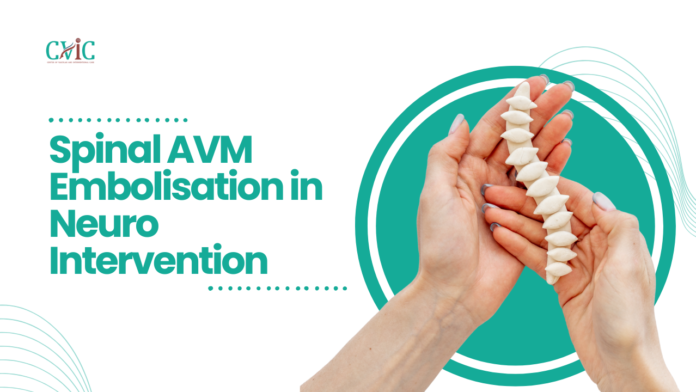Spinal AVM Embolisation is a rare condition where abnormal tangles of blood vessels in the spinal cord disrupt normal blood flow. These malformations can lead to symptoms such as back pain, weakness, numbness, and even paralysis if left untreated. In severe cases, they can even cause bleeding into the spinal cord, leading to potentially life-threatening complications.
Neuro interventional radiologists are specialists who perform minimally invasive procedures to treat conditions affecting the brain and spine, including spinal AVMs. One of the techniques they use is spinal AVM embolization, which involves blocking off the abnormal blood vessels to prevent further complications.
Here’s a detailed look at spinal AVM embolization and how it is performed:
Diagnosis
The first step in treating a spinal AVM is accurate diagnosis. This typically involves imaging studies such as magnetic resonance imaging (MRI) or angiography to visualize the blood vessels in the spine and identify the abnormal tangles characteristic of an AVM.
Planning
Once the neuro interventional team identifies the AVM, they will plan the embolization procedure. This may involve determining the best approach to access the abnormal blood vessels and identifying any potential risks or complications.
Procedure
- Fluoroscopic guidance is used to perform spinal AVM embolization, providing real-time X-ray images of the blood vessels.
- The patient typically receives sedation or anesthesia to ensure comfort during the procedure.
- A catheter (a thin, flexible tube) is inserted into an artery, typically in the groin, and guided through the blood vessels to the site of the AVM in the spine.
Embolization
Once the catheter reaches the AVM, the neuro interventional radiologist will inject a special embolic agent into the abnormal blood vessels. The neurointerventional radiologist designs this agent to block off the blood flow to the AVM, effectively “embolizing” it. Different embolic agents can be used, including coils, glue, or liquid embolic materials, depending on the size and location of the AVM.
Monitoring
Throughout the procedure, the neuro interventional team will be monitoring the progress using fluoroscopy and angiography to ensure that the embolic agent is properly delivered and that blood flow to the surrounding normal tissues is maintained.
Post-procedure care
After completing the embolization, the medical team removes the catheter and applies pressure to the insertion site to prevent bleeding. The patient is typically monitored for a period of time to observe any complications such as bleeding or nerve injury. Pain medication and other supportive care may be provided as needed.
Follow-up
Following spinal AVM embolization, patients will typically undergo follow-up imaging studies to assess the effectiveness of the treatment and monitor for any signs of recurrence or complications. Additional treatments may be necessary in some cases, depending on the response to embolization and the overall health of the patient.
Overall, spinal AVM embolization is an important treatment option for patients with spinal AVMs, offering a minimally invasive alternative to traditional surgery with potentially fewer risks and complications. With advances in imaging technology and interventional techniques, neuro interventional radiologists continue to refine and improve the outcomes of this procedure, providing hope for patients with this challenging condition.
Our Doctors
Dedicated IR Center for Vascular Problems in Madhya Pradesh
DR. SHAILESH GUPTA
MD, PDCC (INTERVENTIONAL RADIOLOGY) Consultant & Co-Director CVIC (Center Of Vascular & Interventional Care)
DR. ALOK KUMAR UDIYA
MD Radiology, PDCC (Neuro intervention Radiology), PDCC ( HPB Intervention Radiology) FINR (Switzerland) & EBIR
Endovascular Surgeon & Consultant Interventional Neuroradiologist at Care CHL Hospital, Indore Co-director CVIC( center for vascular and interventional care)https://interventionradiologyindore.com/
DR. NISHANT BHARGAVA
Consultant Intervention Radiologist
MD Radiology, PDCC ( Neuro intervention Radiology), FINR ( Fellowship in Neuro intervention Radiology)
Co-director CVIC(Center for Vascular and Interventional Care)
Contact Details
Phone no.
0731 4675670
+91 9827760073
Facebook
https://www.facebook.com/profile.php?id=100092538633553&mibextid=ZbWKwL
Instagram
https://instagram.com/cvic_center?igshid=ZGUzMzM3NWJiOQ==
Google My business
https://g.co/kgs/DrdV3T
YouTube
https://www.youtube.com/channel/UCP5TH5e4iQZkpDUgnLsgZhw
Pinterest
https://pin.it/5DzpX5Z
Twitter
https://x.com/cviccenter?t=01TclSrLFdu0K2re0Gs96w&s=08
LINKEDIN
https://www.linkedin.com/company/center-of-vascular-interventional-care/
Location –
Read More –
Angiography in Indore – https://cvicvascular.com/angiography-in-indore/
Pre-operative Embolisation of Tumor in Neuro Intervention – https://cvicvascular.com/pre-operative-embolisation-of-tumor/
Aneurysm coiling in Neuro Intervention – https://cvicvascular.com/aneurysm-coiling-in-neuro-intervention/




